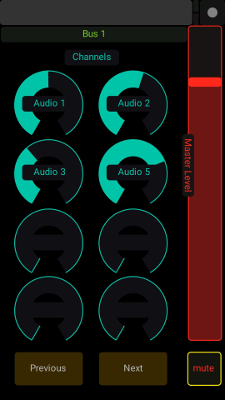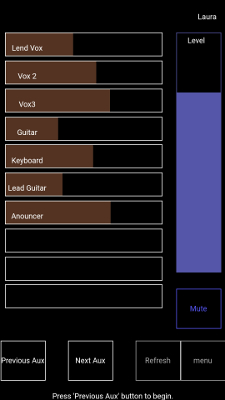Personal Monitoring Control
Personal monitoring can allow a performer with a smart phone to set their personal monitor mix for a floor wedge or in-ear monitoring. In Ardour 5.6 OSC commands to allow this were added for use with aux buses. Ardour 6.0 added Foldback buses for this purpose and these commands work directly for those.
Setup
Foldback buses can be added from the GUI (see: Foldback section) or using the /cue/new_bus OSC command.
- Create a bus for each performer who will have personal monitoring. A good practice is to name the bus with the performers name.
- Connect the output of that bus to one of the audio interface's playback ports that is not otherwise used.
- Add a foldback send to each channel the performer needs to hear in their personal mix. Many performers only need three or four sources to be mixed. If the performer needs to hear a a set of inputs that are combined into a bus, adding the foldback send to that bus may make more sense than adding ten drum channels for example.
- If the performer wishes to hear effects in their monitor, an extra send from the effects bus or a plugin can be added in line in the foldback bus itself. Foldback sends are always just before the Fader.
This gives stage or studio monitoring for the performer.
The OSC commands and feedback for personal monitoring
All of the personal monitoring commands and feedback start with a /cue. It is expected that a surface used as a personal monitor control will use only /cue commands.
There is one OSC command apart from the /cue
commands: /select/add_fldbck_send
Most phone OSC applets (TouchOSC, Control) require manual port to be set. There are certainly more controls than needed. Using send enables for example, may lead to wasted time discovering why a send has no sound. A good easy to use controller that fits on most phones while still being controllable even with big fingers might look like:

|

|
Ardour is not limited to talking to one personal monitor controller at a time, but is able to deal with many simultaneously, each controlling its own foldback bus.
The send controls and feedback all have the send id (1 to n) in line as part of the OSC path. So the path for the second send would be /cue/send/fader/2 to set the level. It is considered that most surfaces used for this will only be able to handle one parameter.
Commands
| /cue/connect | Returns a list of foldback busses and connects to the first. |
|---|---|
| /cue/bus index | where index is an integer or float which is the foldback bus number this surface will use. |
| /cue/next_bus | Sets the the foldback bus to one bus higher. |
| /cue/previous_bus | Sets the foldback bus to one bus lower. This can also be used as a "connect" button to save space in a phone layout. |
| /cue/connect_output output | where output is a string that is the name of an output port or the number of the output port if the port is a system:playback port to connect the foldback bus to. |
| /cue/new_bus name l-output r-output | where name is the name for the new foldback bus as a string, l-output (optional) is the name of the output port to connect to. And r-output (if present) will make the new foldback bus stereo and connect the right output port to the named port. All parameters are string type. |
| /cue/new_send strip | where strip is a string with the name of the strip to add a foldback send to that sends to the current foldback bus. |
| /cue/fader position | where position is a float for the position of the fader between 0.0 and 1.0. |
| /cue/mute state | where state is a float of 0.0 for mute off and 1.0 for the foldback bus mute on. |
| /cue/send/fader/id position | where position is a float for the position of the send fader between 0.0 and 1.0. |
| /cue/send/enable/id state | where state is a float of 0.0 for disable and 1.0 for enable. |
Feedback
| /cue/name name | where name is a string that is the name of the currently selected foldback bus. |
|---|---|
| /cue/name/id name | where name is a string that is the name of the foldback bus that id belongs to. |
| /cue/fader position | where position is a float from 0.0 to 1.0 that shows the fader position for the selected foldback bus. |
| /cue/mute state | where state is a float of 0.0 or 1.0 that shows the state of the mute for the selected foldback bus. |
| /cue/signal activity | where activity is a float of 0.0 or 1.0 that shows audio activity for the selected foldback bus. |
| /cue/send/name/id name | where name is a string that is the name of the channel that send id belongs to. |
| /cue/send/fader/id position | where position is a float from 0.0 to 1.0 that is the position for the fader for the send that id belongs to. |
| /cue/send/enable/id state | where state is a float of 0.0 or 1.0 that is the state of the enable for the send that id belongs to. |
While a fader is being adjusted, the corresponding /*/name text will give the level in db.
Setting up a Foldback bus from a selected strip
A selected or expanded strip can create a foldback send and create a foldback bus at the same time using: /select/add_fldbck_send name where name is a string with the name of the desired foldback bus. If the name matches an existing foldback bus the new send will be added to the selected or expanded strip that feeds that bus. If there is no strip of that name, one will be created.
